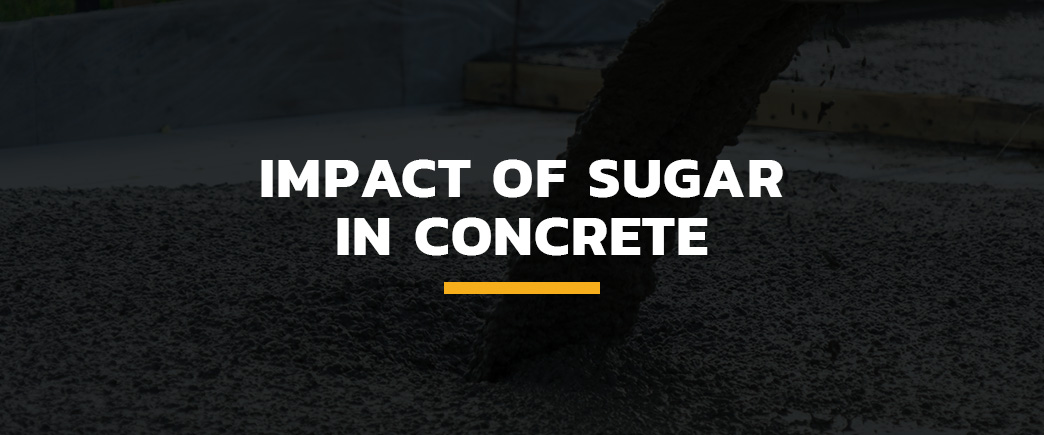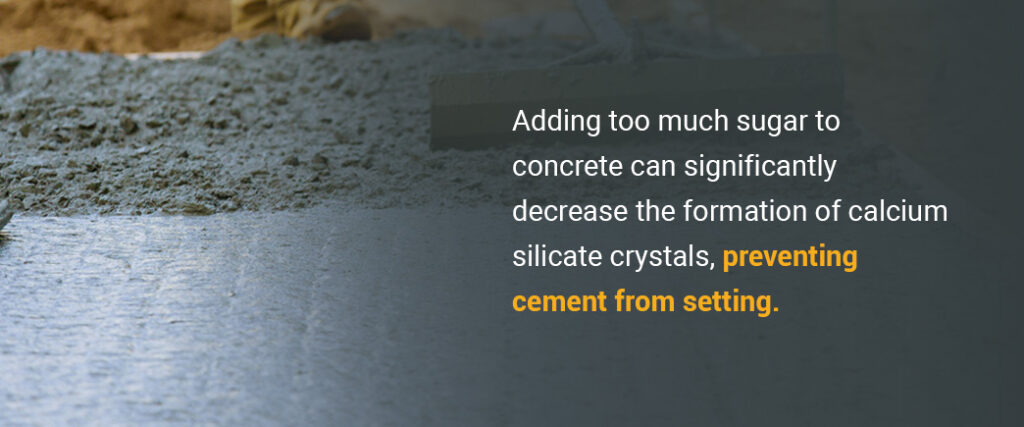Impact of Sugar in Concrete
Posted On: 03/18/2024 | Posted by: DY Concrete Pumps

You want your concrete to be more effective and efficient. But how do you prevent concrete from setting immediately while providing a smooth and consistent finish?
Finding a suitable retarder is the best solution. Choosing one to use is a little more tricky.
Sugar is one of many concrete retarders. While it can help you get the concrete solution you want, it might also have some unfavorable effects. Whether sugar is effective depends on how much you mix in your concrete. Some people can get the consistency right.
Understanding how sugar works in concrete and its results can help determine its effectiveness. Comparing sugar to alternative retarders can help you know how it can impact your structure or work.
Why Do People Add Sugar to Concrete?
Sugar can prevent concrete from setting too quickly and becoming unusable. Concrete that sets too quickly can become stiff and be challenging to use.
For example, hardened concrete spreads less efficiently and can be ineffective in bonding or securing a structure. It also means people must use more concrete, increasing waste and expenses. Adding sugar can keep cement softer, making it more flexible and effective. Sugar is also an affordable and widely available resource.
What Does Sugar Do to Concrete?
Sugar acts as a retardant when you add it to concrete, slowing the hydration process down. Concrete sets through hydration or a chemical reaction between water and cement molecules. Hydration forms calcium silicate, which creates solid crystals. The crystals bind cement and water and help it set. Heat can speed up hydration and bonding, causing concrete to set faster in hot weather.
Why Does Sugar Ruin Concrete?
Adding too much sugar to concrete can significantly decrease the formation of calcium silicate crystals, preventing cement from setting. When concrete doesn’t set, it can become weak and more susceptible to damage and corrosion. Here are some more negative effects of using sugar in concrete:
Improper Setting
While slowing hydration can slow concrete setting time, it can cause it not to set at all. Cement that does set will not harden or cure properly, leaving it vulnerable to the elements and damage.
Moisture Damage
Sugars can absorb liquids, making concrete structures and surfaces more susceptible to water damage. If it rains or you spill liquid on concrete, it might retain moisture, leading to cracking, mold and discolorations.
Less Durability
Sugar impacts the setting and hardening process. It also can create air bubbles in the mixture and increase the air content. Too much air can make concrete less compact. If concrete isn’t dense enough, it can wear quickly when it experiences heavy impacts or high traffic, making it less durable. For example, concrete pavement with lots of foot traffic or heavy loads can become less rigid quickly, showing signs of wear like cracks and holes.
Pest Damage
Mixing sugar in concrete can attract pests like ants and termites. Pests can decay concrete structures like walls and floors over time, compromising the structural integrity. Insects can also invade concrete structures, creating an unpleasant environment.
Aesthetic Defects
While sugar crystals are tiny, they can cause noticeable surface defects when combined with concrete. Sugars can cause white discoloration or efflorescence due to moisture seeping through cracks. It can also cause speckling, spotting or honeycombing, affecting the look of concrete surfaces.
More Expensive
Poorly set concrete can corrode easily, requiring frequent repairs, maintenance and replacements. Replacing concrete slabs or entire structures can be costly, especially if you have to install new concrete sooner or more often than expected.
Unpredictable Setting Times
Sugar can be unpredictable in setting times. Some sugar and concrete mixtures can have longer setting times, while others may cure or harden faster. Unexpected setting time can delay curing, hardening, painting and tiling. It can slow your productivity and completion time.
Low Quality
Putting sugar in concrete can impact its quality. Sugar concentrates can be challenging to control, leading to inconsistent mixtures. You might add too little sugar and have a minimal effect on slowing hydration. Conversely, you might add too much and stop hydration or cement setting altogether.
Poor Workability
Sugar can make concrete mixture either too thin or sticky. You might have difficulty spreading and setting concrete on various structures, affecting the results. For example, when pouring concrete on a surface, the mixture might be thick and bumpy in one area and thin and smooth in the other, causing and uneven or uniform appearance.
Organic Decomposition
Sugar in concrete can break down or decay over time, causing organic decomposition. Decomposition can lead to defects in concrete, like holes, gaps and poor structural integrity.

What Are Retarder Alternatives to Sugar?
Chemical retarders are an excellent alternative to sugar. Professionals use these retarders because they slow down hydration more gradually. The liquid form typically provides better control of mixing quantities and concrete consistency. Chemical retarders also offer a more manageable and workable mixture, making it easier to place and spread. Here are some commonly used chemical retarders:
Retarding Admixtures
Retarding admixtures slows down the reaction between cement and water to reduce the setting time of concrete. Delaying the hydration process can improve the workability of concrete at high temperatures.
Water-Reducing Admixtures
Water-reducing admixtures reduce the water ratio in concrete, increasing its compressive strength. Concrete treated with water-reducing admixtures is often more solid and durable under heavy loads.
Accelerating Admixtures
Accelerating or set-controlling admixtures combine the benefits of retarding and water-reducing admixtures. When added to concrete or cement, these retarders increase hydration, reduce setting time and increase early strength development in concrete. Professionals can use accelerating admixtures to improve start-up and finishing processes and enhance the workability of cement in cold conditions.
Superplasticizers
Unlike retarding admixtures, superplasticizers increase concrete workability and strength without changing the water-to-cement ratio. These retarders can produce high-strength, cohesive and smoother concrete finishes. They can also reduce the concrete needed in projects and withstand freezing conditions. Professionals can use superplasticizers in pumped concrete for building high-rise budlings and bridges.
Use Suitable Concrete Solutions From DY Concrete Pumps
Getting the right concrete consistency is essential for your high-quality work. Unset concrete can impact structural durability, appearance and longevity. If your concrete sets too quickly, it can affect your ability to spread and use it.
Whatever retarder you decide on, you’ll need the right tools. DY Concrete Pumps has a large inventory of concrete pumps, pump parts and small equipment. We’re also proud to offer exceptional technical support and concrete pump repairs. Contact us to find a concrete pump for your job.


 1-844-397-8677
1-844-397-8677



